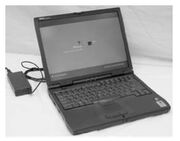mNo edit summary Tag: sourceedit |
|||
| (One intermediate revision by the same user not shown) | |||
| Line 1: | Line 1: | ||
== Definition == |
== Definition == |
||
| + | [[File:Laptop.jpg|thumb]] |
||
| ⚫ | |||
| + | |||
| ⚫ | |||
| + | |||
| + | {{Quote|mobile device[] with a full-featured [[operating system]] (e.g. [[Microsoft Windows]], [[Apple OS X]], [[LINUX]]/[[UNIX]], etc.). Laptops are typically intended for transport via vehicle mount or portfolio-sized carry case, but not on the body. This definition does not include [[pocket PC|pocket]]/[[handheld device]]s (e.g. [[smartphone]]s), or [[mobile device]]s that feature a limited feature [[operating system]] (e.g. [[tablet]]s).<ref>[[Criminal Justice Information Services Security Policy]], Glossary, at A-7.</ref>}} |
||
== Overview == |
== Overview == |
||
| Line 8: | Line 12: | ||
Laptops contain components that are similar to their [[desktop]] counterparts and perform the same functions, but are miniaturized and optimized for mobile use and efficient power consumption, although typically less powerful for the same price. Laptops usually have liquid crystal [[display]]s and most of them use different memory modules for their [[random access memory]] ([[RAM]]). In addition to a built-in [[keyboard]], they may utilize a touchpad (also known as a trackpad) or a pointing stick for [[input]], though an external [[keyboard]] or [[mouse]] can usually be attached. |
Laptops contain components that are similar to their [[desktop]] counterparts and perform the same functions, but are miniaturized and optimized for mobile use and efficient power consumption, although typically less powerful for the same price. Laptops usually have liquid crystal [[display]]s and most of them use different memory modules for their [[random access memory]] ([[RAM]]). In addition to a built-in [[keyboard]], they may utilize a touchpad (also known as a trackpad) or a pointing stick for [[input]], though an external [[keyboard]] or [[mouse]] can usually be attached. |
||
| + | |||
| + | == References == |
||
| + | <references /> |
||
Latest revision as of 15:45, 29 July 2016
Definition[]

A laptop device, or simply laptop (also referred to as a notebook computer, notebook and notepad) is a
| “ | mobile device[] with a full-featured operating system (e.g. Microsoft Windows, Apple OS X, LINUX/UNIX, etc.). Laptops are typically intended for transport via vehicle mount or portfolio-sized carry case, but not on the body. This definition does not include pocket/handheld devices (e.g. smartphones), or mobile devices that feature a limited feature operating system (e.g. tablets).[1] | ” |
Overview[]
Laptops usually run on a single main battery or from an external AC/DC adapter that charges the battery while also supplying power to the computer itself. Many computers also have a 3 volt cell to run the clock and other processes in the event of a power failure.
Laptops contain components that are similar to their desktop counterparts and perform the same functions, but are miniaturized and optimized for mobile use and efficient power consumption, although typically less powerful for the same price. Laptops usually have liquid crystal displays and most of them use different memory modules for their random access memory (RAM). In addition to a built-in keyboard, they may utilize a touchpad (also known as a trackpad) or a pointing stick for input, though an external keyboard or mouse can usually be attached.
References[]
- ↑ Criminal Justice Information Services Security Policy, Glossary, at A-7.
| This page uses Creative Commons Licensed content from Wikipedia (view authors). | 
|